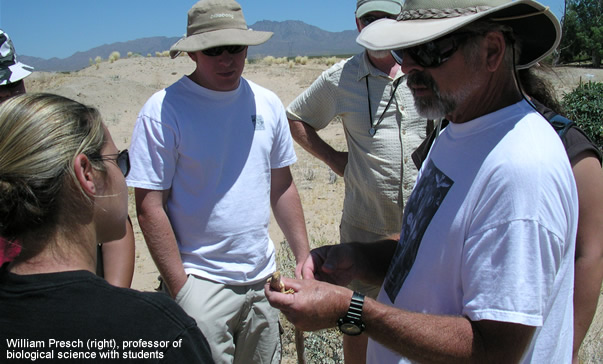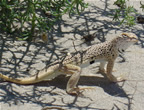Biologist Studies How Small Mojave Lizard Exists Despite High Heat and ‘Sand People’
November 13, 2006
By Laurie McLaughlin
Mojave fringe-toed lizards are tailor-made for the harsh desert environment they call home. They have fringes on their hind feet that allow them to run across sand dunes; the openings in their noses face backward so that when they dive into the sand, they don’t get a snout full of dirt; and the fringes around their upper and lower eyelids keep sand out of their eyes.
William Presch has been studying lizards for more than 30 years, and the fringe-toed lizard has been the subject of his research off and on for most of his career. “As an undergraduate in 1964, I went on a field trip into Mexico, just south of the border, with a professor who was a herpetologist,” remembers Presch, professor of biological science. “I decided this was pretty cool stuff, and I liked chasing lizards.” He liked it so much that he earned both a master’s and doctorate in the study of the herpetology.
Presch is director of the Desert Studies Consortium, which is made up of seven CSU institutions. The consortium operates the Desert Studies Center, located between Barstow and Las Vegas at Soda Springs, Calif., on the western edge of the Mojave National Preserve. Presch, who has been director since 1991, makes the two-and-a-half-hour drive out to the center regularly and sometimes stays for as long as 10 days to help with classes the center offers or to conduct research on local plants and animals.
Because of the center’s focus on healthy desert wildlife, it has a close relationship with the Bureau of Land Management and the National Park Service, the federal agencies charged with maintaining the area’s habitat. A couple of years ago, BLM officials approached Presch to ask if he’d be interested in studying the status of the Mojave fringe-toed lizard (U. scorpia Cope).
“There wasn’t any consistency in the current data, and they wanted to know whether the lizards were still there and what the population size was,” says Presch. “They also were interested in the effect motorized recreation was having on the lizard.”
The federal agency has awarded $47,150 as part of a five-year grant to document the lizards’ home turf and how well it’s shared with those who enjoy the wide open, sandy spaces the desert offers users of off-highway vehicles (OHVs), a group referred to as “sand people.”
“Environmentalists are concerned that these OHV riders in the sand dunes are a detriment to the lizard,” says Presch. “And, the question in my mind, through my 32 years of experience, was whether or not the lizard was living throughout the entire range in which ‘sand people’ recreate. These lizards are very specific in their habitat, and their numbers seem to be dropping.”
The lizards skillfully manage existence within the hot desert and, Presch says, there must be a number of factors in place in order for them to make their homes. “They live near particular types of plants, and the gravel cannot be too large.” The lizards also have a restricted season where they come out to be observed, and are active only from April to mid-July. “If it’s above 120 degrees Fahrenheit, it’s too hot for them, so they go down and burrow back into a hole. They prefer the sand to be about 95 degrees, so you can set out on a nice June day to observe them … but if the temperature is 90 degrees by 8 in the morning, you better be there, because the sand temperature will be up to 165 degrees by 10:30 a.m.”
Presch and his five-member team, which includes an undergraduate student, two of his former graduate students and a colleague also interested in lizards, are studying the parks both in Death Valley and the Mojave Desert National Preserve. “In the first year of this study [2005], we covered 162 square kilometers. We’ve been able to define the habitat in great detail and eliminated some of the areas we previously thought the lizards might be.”
The team is comparing land that is open to the public and used by “sand people” to the areas in the Mojave National Preserve and in Death Valley, which are closed to OHV riders. “Of course, in this restricted area, the dunes are in wilderness, which makes the research even more difficult,” says Presch, but he likes the challenge. “My laboratory is in the environment, out in the real world.”
The concern for the desert environment and the effect of off-road recreation is not a new one, and Presch’s work is designed to create data that will help officials create both a home and a playground for both reptile and human. A popular belief is that damage caused by OHVs may include trampling of vegetation that provides shelter from the heat for the fringe-toed lizards, and perhaps the death and maiming of fleeing or buried lizards and destruction of their underground eggs, said Presch. Part of the concern is that local populations of the lizards will continue to decline as they become more isolated from the damage created by OHVs and will not reproduce. Presch noted that the work is designed to examine these ideas.
“This is a big problem in the desert because riding OHVs is one form of recreation that can be done in the desert, and as the number of people who can afford the sport increases, they need to have a place to go,” says Presch. “So we need to know more about the habitat and manage it so that the lizard can have its land to run around in and ‘sand people’ can have their land to run around in.”



 Produced by the Office of Public Affairs at California State University, Fullerton.
Produced by the Office of Public Affairs at California State University, Fullerton.